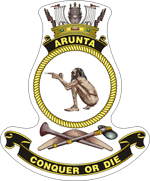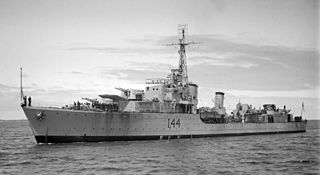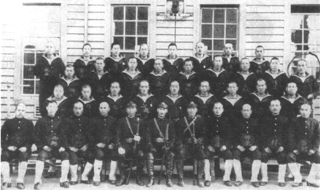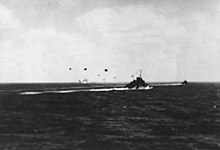
USS Phoenix (CL-46), was a light cruiser of the Brooklyn-class cruiser family. She was the third Phoenix of the United States Navy. After World War II the ship was transferred to Argentina in 1951 and was ultimately renamed General Belgrano in 1956. General Belgrano was sunk during the Falklands War in 1982 by the British nuclear-powered submarine HMS Conqueror, the only ship to have been sunk in combat by a nuclear-powered submarine during wartime.

The Battle of the Java Sea was a decisive naval battle of the Pacific campaign of World War II.

HNLMS Tromp was the lead ship of the Tromp-class destroyer leaders built for the Royal Netherlands Navy. Built just prior to World War II, the ship served mainly in the Pacific and Indian Oceans against the Japanese, being based out of Sydney, Fremantle and Trincomalee where she served alongside British, Australian and US warships. After the war, she returned to the Netherlands and after 1949 Tromp was used as a training and accommodation ship, before being decommissioned in 1955, and scrapped in 1969.

HMAS Hobart was a modified Leander-class light cruiser which served in the Royal Australian Navy (RAN) during World War II. Originally constructed for the Royal Navy as HMS Apollo, the ship entered service in 1936, and was sold to Australia two years later. During the war, Hobart was involved in the evacuation of British Somaliland in 1940, fought at the Battle of the Coral Sea and supported the amphibious landings at Guadalcanal and Tulagi in 1942. She was torpedoed by a Japanese submarine in 1943, then returned to service in 1945 and supported the landings at Tarakan, Wewak, Brunei, and Balikpapan. Hobart was placed in reserve in 1947, but plans to modernise her and return her to service as an aircraft carrier escort, training ship, or guided missile ship were not followed through. The cruiser was sold for scrapping in 1962.

HMAS Australia (I84/D84/C01) was a County-class heavy cruiser of the Royal Australian Navy (RAN). One of two Kent-subclass ships ordered for the RAN in 1924, Australia was laid down in Scotland in 1925, and entered service in 1928. Apart from an exchange deployment to the Mediterranean from 1934 to 1936, during which she became involved in the planned British response to the Abyssinia Crisis, Australia operated in local and South-West Pacific waters until World War II began.

HMAS Perth was one of three modified Leander-class light cruisers used by the Royal Australian Navy (RAN) during the early part of World War II. She was built for the Royal Navy (RN) in the mid-1930s and was commissioned as HMS Amphion in 1936. The ship spent the next several years as flagship of the Commander-in-Chief, Africa before she was transferred to the RAN in 1939 and renamed as HMAS Perth.

HMAS Arunta (I30/D5/D130) was a Tribal-class destroyer of the Royal Australian Navy (RAN). Named for the Arrernte Aboriginal peoples, the destroyer was laid down in 1939 and commissioned into the RAN in 1942.

The Battle of Sunda Strait was a naval battle which occurred during World War II in the Sunda Strait between the islands of Java, and Sumatra. On the night of 28 February – 1 March 1942, the Australian light cruiser HMAS Perth and the American heavy cruiser USS Houston faced a major Imperial Japanese Navy (IJN) task force. After a fierce battle lasting several hours, both Allied ships were sunk. Five Japanese ships were sunk, three of them by friendly fire.

HMAS Warramunga (I44/D123) was a Tribal-class destroyer of the Royal Australian Navy (RAN). Built during World War II, the destroyer entered service in late 1942. She was initially assigned to convoy escort duties, but was assigned to the joint Australian-American Task Force 74 in 1943, and was involved in supporting numerous amphibious landings through the South-east Asian region until the end of the war. From 1950 and 1952, Warramunga fought in the Korean War, then was converted into an anti-submarine destroyer. Returning to service in 1954, the destroyer was one of the first RAN ships to operate with the Far East Strategic Reserve, and undertook two tours with the organisation before she was decommissioned in 1959 and sold for ship breaking in 1963.

HMAS Canberra (I33/D33), named after the Australian capital city of Canberra, was a Royal Australian Navy (RAN) heavy cruiser of the Kent sub-class of County-class cruisers. Constructed in Scotland during the mid-1920s, the ship was commissioned in 1928, and spent the first part of her career primarily operating in Australian waters, with some deployments to the China Station.

The first HMAS Bendigo (J187/B237/A111) was a Bathurst-class minesweeper, a group commonly known as corvettes and including escort and patrol duties along with minesweeping.

The history of the Royal Australian Navy traces the development of the Royal Australian Navy (RAN) from the colonisation of Australia by the British in 1788. Until 1859, vessels of the Royal Navy made frequent trips to the new colonies. In 1859, the Australia Squadron was formed as a separate squadron and remained in Australia until 1913. Until Federation, five of the six Australian colonies operated their own colonial naval force, which formed on 1 March 1901 the Australian Navy's (AN) Commonwealth Naval Force which received Royal patronage in July 1911 and was from that time referred to as Royal Australian Navy (RAN). On 4 October 1913 the new replacement fleet for the foundation fleet of 1901 steamed through Sydney Heads for the first time.

The invasion of Tulagi, on 3–4 May 1942, was part of Operation Mo, the Empire of Japan's strategy in the South Pacific and South West Pacific Area in 1942. The plan called for Imperial Japanese Navy troops to capture Tulagi and nearby islands in the British Solomon Islands Protectorate. The occupation of Tulagi by the Japanese was intended to cover the flank of and provide reconnaissance support for Japanese forces that were advancing on Port Moresby in New Guinea, provide greater defensive depth for the major Japanese base at Rabaul, and serve as a base for Japanese forces to threaten and interdict the supply and communication routes between the United States and Australia and New Zealand.

HMAS Warrego (L73/U73), named for the Warrego River, was a Grimsby-class sloop of the Royal Australian Navy (RAN).

USS Isabel (SP-521), later PY-10, was a yacht in commission in the United States Navy as a destroyer from 1917 to 1920 and as a patrol yacht from 1921 to 1946.
The Pensacola Convoy is a colloquialism for a United States military shipping convoy that took place in late 1941 as the Pacific War began. The name was derived from that of its primary escort ship, the heavy cruiser USS Pensacola. Pensacola was officially designated Task Group 15.5 and Army sources may use the term Republic convoy for the senior convoy vessel. The convoy, dispatched in peacetime, was intended to reinforce the United States Army Forces Far East (USAFFE), created to defend the U.S. Commonwealth of the Philippines and commanded by General Douglas MacArthur, with artillery, aircraft, munitions and fuel, as the threat of war with the Empire of Japan loomed. After war broke out, and Japanese forces attacked the Philippines, the convoy was diverted to Brisbane, Australia.

Vice Admiral Sir Henry Mackay Burrell, was a senior commander in the Royal Australian Navy (RAN). He served as Chief of the Naval Staff (CNS) from 1959 to 1962. Born in the Blue Mountains, Burrell entered the Royal Australian Naval College in 1918 as a 13-year-old cadet. His first posting at sea was aboard the cruiser HMAS Sydney. During the 1920s and 1930s, Burrell served for several years on exchange with the Royal Navy, specialising as a navigator. During World War II, he filled a key liaison post with the US Navy, and later saw action as commander of the destroyer HMAS Norman, earning a mention in despatches.

The ANZAC Area, also called the ANZAC Command, was a short-lived naval military command for Allied forces defending the northeast approaches to Australia including the Fiji Islands, New Hebrides, and New Caledonia during the early stages of the Pacific Campaign of World War II. The command was created on 27 January 1942. United States Navy Vice Admiral Herbert Fairfax Leary commanded the force. The force co-existed with the Allied ABDA command which was charged with defending Allied colonial territories in Southeast Asia and the Southwest Pacific from Imperial Japanese aggression.
The ANZAC Squadron, also called the Allied Naval Squadron, was an Allied naval warship task force which was tasked with defending northeast Australia and surrounding area in early 1942 during the Pacific Campaign of World War II. The squadron, consisting of cruisers and destroyers from the navies of Australia, New Zealand, and the United States was formed on February 12, 1942, under the command of Royal Navy Rear Admiral John Gregory Crace. The squadron was the primary fleet element operating in the ANZAC Area under the overall command of United States Navy Vice Admiral Herbert Fairfax Leary.

The Eastern Fleet, later called the East Indies Fleet, was a fleet of the Royal Navy which existed between 1941 and 1952.


















